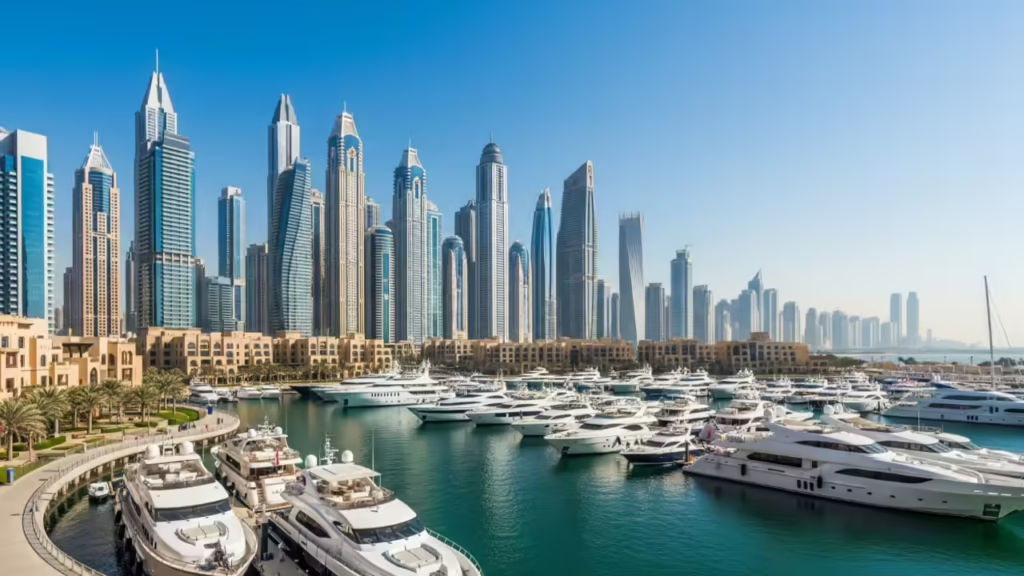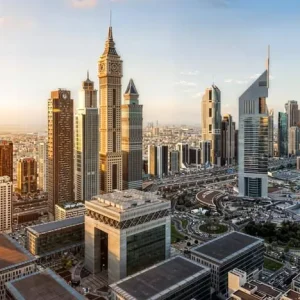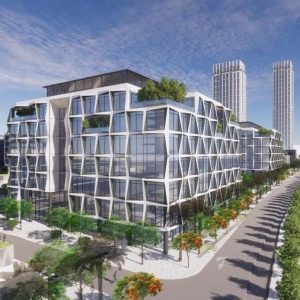Dubai Property Rental Yields Hit Record Highs in Q3 2025, marking another milestone for the city’s booming real estate sector. Investors across the globe are turning their attention to the UAE’s most dynamic property market as strong rental demand, limited supply, and economic optimism continue to push yields upward. The trend reflects Dubai’s growing appeal as both a lucrative investment destination and a thriving global city offering stability, innovation, and high quality of life.
Over the past year, Dubai has witnessed remarkable growth in both residential and commercial rentals, driven by a surge in population, corporate relocations, and the continued influx of expatriates. The result is record-breaking rental returns that are outpacing major global cities and cementing Dubai’s reputation as a leading investment hotspot.
Dubai Property: Rising Demand and Tight Supply Drive Rental Surge
The key driver behind Dubai’s soaring rental yields is the ongoing imbalance between supply and demand. While new property launches have increased across various districts, the pace of delivery still lags behind the surge in demand from both end-users and tenants.

Popular communities like Dubai Marina, Downtown Dubai, Business Bay, and Jumeirah Village Circle have seen rental prices jump by more than 20% in the past year alone. The influx of professionals and entrepreneurs seeking long-term residence options has added pressure to the market, particularly for mid-range apartments and villas.
The strong demand isn’t limited to expatriates—many local investors and GCC nationals are also choosing to diversify their portfolios with income-generating assets in Dubai. As a result, property owners are seeing unprecedented returns, especially in high-demand neighborhoods close to metro stations, business districts, and lifestyle destinations.

The Investor’s Advantage: High Yields Across Property Segments
For investors, Dubai’s property market has become a prime opportunity for generating steady and strong passive income. Average gross rental yields across the city reached 7.5% in Q3 2025, with some communities exceeding 10%—a figure rarely seen in global real estate markets.
Studio and one-bedroom apartments, in particular, continue to offer the highest yields due to affordability and constant tenant demand. In areas like Jumeirah Village Circle, Discovery Gardens, and Dubai Silicon Oasis, investors are benefiting from shorter vacancy periods and higher monthly rents.
Luxury properties have also performed impressively, with areas such as Palm Jumeirah and Dubai Hills Estate attracting high-net-worth tenants seeking premium residences. These prime properties not only deliver attractive yields but also promise long-term capital appreciation as Dubai’s real estate sector continues to mature.
Economic Growth and Business Expansion Boost Market Confidence
Dubai’s broader economic momentum has played a crucial role in driving rental performance. The emirate’s diversified economy—spanning tourism, finance, trade, logistics, and technology—continues to attract international businesses and talent.
Major global firms have expanded their Middle East headquarters in Dubai, while new startups and entrepreneurs have flocked to free zones like Dubai Internet City and DIFC. This influx of professionals has increased demand for rental housing across various price segments.
Additionally, the UAE’s visa reforms, including the Golden Visa and long-term residency programs, have encouraged more expatriates to settle permanently. This demographic shift is strengthening Dubai’s rental market, as tenants transition from short-term stays to long-term leases, creating more stable demand and higher yields for landlords.
Affordable Communities Outperform with Exceptional Returns
While luxury districts attract media attention, it is the affordable and mid-market areas that are currently leading in rental yield performance. Communities such as Jumeirah Village Circle (JVC), Dubai Sports City, and International City have emerged as strong performers due to their accessibility, modern infrastructure, and reasonable rents.
These neighborhoods are particularly popular among young professionals, small families, and remote workers looking for well-connected yet affordable accommodation. As rental rates in premium areas continue to climb, many tenants are shifting to these cost-effective communities, further increasing demand and supporting high yields for investors.
JVC, for example, now offers average yields exceeding 9%, driven by its mix of affordable apartments, new co-living developments, and proximity to major roads like Al Khail and Sheikh Mohammed Bin Zayed Road.
The Impact of Smart and Sustainable Living
Another factor fueling Dubai’s rental market growth is the city’s embrace of smart housing and sustainable development. Developers are increasingly integrating technology, energy efficiency, and modern design into their projects to meet evolving tenant preferences.
Smart homes equipped with automation systems, energy-saving appliances, and green spaces are attracting tenants willing to pay a premium for convenience and sustainability. Areas featuring mixed-use developments—combining residential, retail, and recreational spaces—are seeing particularly strong occupancy rates.
The rise of smart living solutions aligns with Dubai’s long-term vision to create sustainable urban environments that balance modernity with environmental responsibility. For investors, this means properties with smart features are likely to maintain higher occupancy and yield stronger returns in the years ahead.
Expo Legacy and Infrastructure Expansion Continue to Add Value
Dubai’s strategic investments in infrastructure continue to elevate its property market potential. Projects such as the expansion of the Dubai Metro, the upcoming Blue Line, and improved road connectivity have made commuting easier and increased the appeal of emerging districts.
The legacy of Expo 2020 also continues to boost demand in nearby areas like Dubai South, where commercial and residential projects are thriving. The site’s transformation into District 2020—a hub for innovation, logistics, and business—has created new real estate demand from professionals working in these sectors.
With the city’s continuous expansion and improvement in public transport and amenities, Dubai’s property landscape is well-positioned for long-term growth.
The Role of Data and Transparency in Attracting Global Investors
One of the reasons Dubai’s property market continues to attract foreign investment is its increasing transparency. Government initiatives such as the Dubai REST app and open data policies allow investors to track real-time property prices, transaction volumes, and community trends.
This accessibility builds trust and helps investors make informed decisions, reducing risks and encouraging greater participation in the market. Combined with Dubai’s tax-free environment and robust legal protections for property ownership, it’s no surprise that global investors view the city as a secure and high-performing destination.
The Dubai Land Department’s consistent efforts to digitalize property transactions have also streamlined the investment process, making it easier for overseas buyers to acquire and manage real estate remotely.
Short-Term Rentals and Holiday Homes Add to the Upside
Another segment that’s contributing to Dubai’s record rental yields is the booming short-term rental market. With tourism continuing to surge, especially after the success of major global events and the UAE’s growing reputation as a year-round travel destination, holiday homes are in high demand.
Areas like Downtown Dubai, Dubai Marina, and Jumeirah Beach Residence are leading this segment, as visitors seek premium short-term stays with views of landmarks such as Burj Khalifa and Ain Dubai. Property owners leveraging platforms like Airbnb and Booking.com are seeing impressive returns—often higher than traditional long-term leases.
This trend is creating a new class of hybrid investors who combine long-term stability with short-term profitability, further boosting overall market performance.

Expert Outlook: A Sustainable Growth Trajectory
Real estate experts believe Dubai’s property market is entering a phase of sustainable, long-term growth rather than a speculative boom. The combination of rising population, economic diversification, and stable government policies has created a strong foundation for consistent performance.
While some short-term fluctuations are inevitable as new projects are delivered, the overall trend points toward continued stability and attractive returns. For investors, this means opportunities will remain abundant, particularly in communities offering a mix of affordability, lifestyle amenities, and transport connectivity.
Conclusion – Dubai’s Rental Market Sets a Global Benchmark
The story of Dubai property rental yields hitting record highs in Q3 2025 underscores the emirate’s resilience and attractiveness as a real estate powerhouse. Whether for seasoned investors or newcomers seeking reliable income, Dubai offers one of the world’s most compelling property markets.
With strong demand, visionary urban planning, and investor-friendly policies, the city continues to deliver exceptional value and growth potential. From affordable apartments in up-and-coming neighborhoods to luxury villas with waterfront views, the opportunities are as diverse as the city itself.
As Dubai continues to evolve into a global hub for living, working, and investing, one thing is clear—the emirate’s real estate market is not just booming, it’s setting new records that redefine success in global property investment.
Do follow UAE Stories on Instagram
Read Next – Eaton Starts Building Next-Gen Engineering and Manufacturing Center in Dubai














